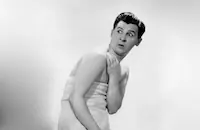Director and Producer George Abbot, known as the "Wizard of Broadway," had also produced the stage version of Too Many Girls, and brought Arnaz and co-star Eddie Bracken from the hit show to star in the movie. Fellow actors Hal LeRoy, Libby Bennett, Ivy Scott, Byron Shores, and an unknown Van Johnson also reprised their roles. With the exception of LeRoy, this was the film debut for all the actors. As a chorus boy, a red-headed Van Johnson made such an impression upon studio executives that he was offered a studio contract as a result of his performance. Other additions included Ann Miller, renowned for her tap dancing skills, and Richard Carlson, an actor best remembered for appearing in 3-D horror/sci-fi flicks like Creature from the Black Lagoon (1954) and It Came From Outer Space (1953). Finally, rounding out the cast was Lucille Ball, cast in the lead role as a heiress who pays a visit to Pottawatomie College in Stopgap, New Mexico, where she is shadowed by four bodyguards in disguise. After working in the film industry for seven years, Ball was finally gaining popularity and garnering favorable reviews with her work.
However, from the first meeting between Lucille and Desi (cast in the supporting role of Manuelito Lynch), there were definitely fireworks. After the encounter, Arnaz promptly advised Abbott to fire Ball, having surmised that she was "too tough and common for the role." Abbott wisely did not heed Desi's input, but he was forced to make some changes to the plot to please the Hollywood executives. In the Broadway version, the wearing of beanies denotes virgin girls; in the film version the beanies were indicators that the wearers had never been kissed. The name of the production, however, remained the same, which was rather appropriate in Desi's case. At the time of meeting Ball, he was engaged to a dancer, Renee De Marco, and he had already gained quite a ladies' man reputation by dating women like Betty Grable among others. At a pool party thrown by Eddie Bracken, however, Ball was not deterred by the competition. Patting the sand beside her, she told Desi to sit down. He did, and they left together a few hours later - his engagement to De Marco effectively ended.
The electricity between the two did not go unnoticed by the cast; in fact, their co-stars placed hefty wagers about the duration of the relationship. Eddie Bracken would ultimately win the bet, as he guessed the longest amount of time: six months. The tumultuous union between Ball and Arnaz would ultimately end, but only after twenty years, five Emmys, and an indelible mark on television history. Detractors cited such reasons for the break-up as too much jealousy, too much work, and too much distrust. For whatever reason it ended, however, it all began with Too Many Girls.
Producer: George Abbott, Harry E. Edington
Director: George Abbott
Screenplay: George Marion, Jr. (author of the musical play), John Twist
Art Direction: Van Nest Polglase
Cinematography: Frank Redman
Film Editing: William Hamilton
Original Music: Richard Rodgers
Principal Cast: Lucille Ball (Consuelo 'Connie' Casey), Richard Carlson (Clint Kelly), Ann Miller (Pepe), Eddie Bracken (Jojo Jordan), Frances Langford (Eileen Eilers), Desi Arnaz (Manuelito Lynch), Hal LeRoy (Al Terwilliger).
BW-86m. Closed captioning.
by Eleanor Quin




























